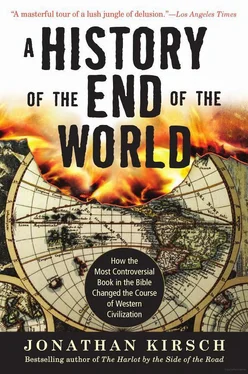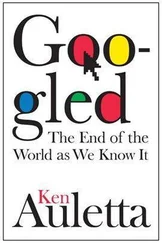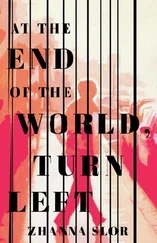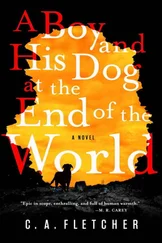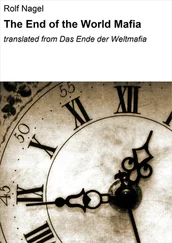“Like so many others, I had lived in an atmosphere of illusion, thinking that once certain obstacles were removed, especially the disenfranchisement of women, it would be full steam ahead for the ideal social and international order,” Pankhurst declared. “But when, in 1918, I really faced the facts, I saw that the war was not a war to end war—but was, despite our coming victory, a beginning of sorrows.” 109
Viewed through the lens of biblical prophecy, in fact, the shattering events of the First World War made perfect sense to the apocalyptic mind. Russia was identified as the biblical kingdom of Gog, and the toppling of the czar by the Bolsheviks in 1917 was seen as the fulfillment of a prophecy in the book of Ezekiel: “Thus saith the Lord God: Behold, I am against thee, O Gog.” 110The Balfour Declaration of 1917, which committed Great Britain to the establishment of a Jewish homeland in Palestine, and the liberation of Jerusalem from the Turks in 1918 by the British army, were interpreted as “the beginning of a series of events that are destined to establish God’s kingdom here upon earth,” according to an enthusiastic Bible commentator named E. L. Langston. 111
“The Jews and the land of Palestine are like charts to the mariner,” Langston explains. “As we study the prophecies concerning ‘the people’ and ‘the land’ we hold the key to the mysteries of God’s plan and purpose for the world.” 112
Like Daniel in Babylon, like John in pagan Rome, men and women in twentieth-century America were ready to see signs of the approaching end all around them. “Wars and rumors of war” produced a constant and mounting thrum of anticipation in Christian circles. For them, as for readers of Revelation across the last twenty centuries, even the bad news could be seen as good news.
Thus did Revelation begin to work its old magic on the hearts and minds of otherwise modern men and women. At various points in the long history of the ancient text, as we have seen, the number 666 was understood to identify Nero, Alaric, Muhammad, or Napoleon. Now the same number was variously understood by the latest generation of apocalyptic code-breakers to reveal the names of Lenin and Stalin, Hitler and Mussolini, even Franklin Delano Roosevelt—all depending on the specific political stance of the beholder.
Some of the apocalyptic excess on display in the wake of the Great War was downright scandalous. The Pentecostal preacher Aimee Semple McPherson (1890–1944) was capable of moving her congregation and her radio audience to moments of rapture with high-spirited sermons on the Second Coming. Clad in colorful if also bizarre costumes and backed by a fifty-piece stage orchestra, she purported to engage in acts of faith healing and “spirit slaying.” A verse from the book of Revelation appeared on the masthead of The Bridal Call, a publication of McPherson’s International Church of the Foursquare Gospel: “And the Spirit and the bride say, Come…” 113But she ended up a victim of her own passions: a mysterious sojourn in the desert was rumored to be nothing more than a shack-up with her lover, a radio technician on the church staff, and she died of an overdose of barbiturates.
Other examples are comical. One apocalyptic sect called the House of David, for example, sought to gather the lost twelve tribes in anticipation of the coming millennial kingdom. The House of David fielded a baseball team whose players sported long beards that were meant to suggest Old Testament prophets, and the team put on exhibition games across the country to raise money and attract new members. Advertised as a celibate community, the House of David attracted its own scandal when its founder, who styled himself as King Benjamin and his wife as Queen Mary, landed in jail on charges of fraud and seduction.
Still other uses of the iconography of Revelation were purely rhetorical and wholly secular. Sportswriters in the mid-1920s dubbed the four players who made up the backfield of coach Knute Rockne’s football team at Notre Dame as “The Four Horsemen,” and the same term was applied to four conservative members of the Supreme Court who voted to strike down various components of the New Deal during the Roosevelt administration in the 1930s. When one apocalyptic preacher in Los Angeles claimed that the “mark of the beast” was actually the stylized blue eagle that served as the logo of the National Recovery Administration—the centerpiece of the New Deal—even otherwise pious observers were forced to crack a smile.
“Who that has seen it,” wrote Ernest Cadman Colwell in 1937, “can ever forget the rapt expression of the interpreter who found the explanation of the Beast of Revelation in the N.R.A.?” 114
Yet some of the most inventive interpreters of Revelation were utterly earnest when it came to the new meanings that they prized out the ancient biblical text. They were so respectful of the apocalyptic tradition that they regarded Benito Mussolini as a more likely Antichrist than Adolf Hitler precisely because Mussolini reigned in the city of Rome, the seat of ancient Roman paganism and the object of such fear and loathing in the book of Revelation. Indeed, Mussolini caught the attention of Christian apocalyptic observers when he first came to power in the 1920s, and Il Duce remained in their crosshairs long after Der Führer had proved himself to be far more beastly.
“I am not prepared to say Stalin, Hitler, or Mussolini is the beast,” declared the pastor of a Baptist church in New York City, “but I have no hesitation in saying they are his forerunners and are beating the trail for him to come upon the scene. Mussolini, above them all, bears the earmarks.” 115
Thus, for example, the salute that was originated by Mussolini’s Fascist Party (and only later adopted by the Nazis), with its open palm and upraised arm, was linked to the passage in Revelation where it is said that the Beast “causeth all to receive a mark in their right hand.” 116According to evangelist W. D. Herrstrom, “it is certain that the people of the world will be required to raise their right hands with a movement similar to the present Fascist salute in order to show the mark during the reign of the beast.” 117And the fasces that appeared on the American dime in the 1930s—the bundle of rods with a projecting ax blade that originally represented the magisterial authority of ancient Rome and later served as a symbol of the Fascist party in Italy—was seen as yet another example of “the mark of the beast.”
On at least one occasion, in fact, such apocalyptic speculation prompted a face-to-face confrontation with Mussolini himself. A husband-and-wife team of Christian journalists from Belgium, Mr. and Mrs. Ralph Norton, managed to secure an audience with Il Duce, and they asked in the course of their interview whether he intended to reestablish the Roman Empire. When he replied that it would be impossible to do so, they boldly witnessed to the Fascist dictator about the prophecy that Rome, symbolized in Revelation as “Babylon, the Mother of Harlots and Abominations of the Earth,” 118would be reborn and then destroyed in the end-times.
“Is that really described in the Bible?” asked the astounded Mussolini. “Where is it found?” 119
Mussolini, of course, was no laughing matter. The atrocities of the Second World War and the Holocaust beggared even the apocalyptic imagination, and they readily suggested a kind of Armageddon. “Human history [is] moving toward a climax in which evil becomes more and more naked and unashamed,” conceded theologian Reinhold Niebuhr in 1940. 120Yet the theological calculus of Revelation prompts the true believer to see even the worst atrocities—and especially the worst atrocities—as a sign that the Second Coming is fast approaching.
Читать дальше
